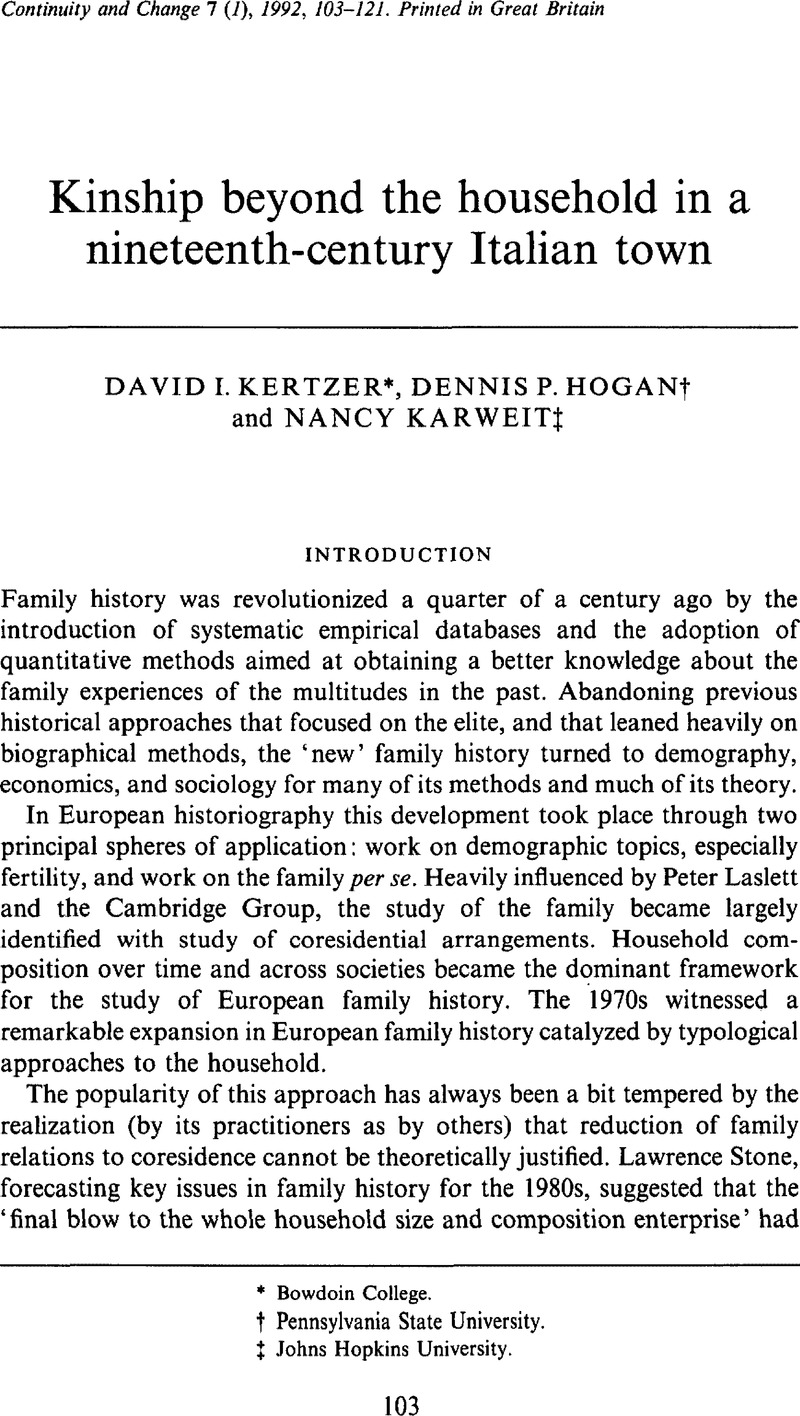Published online by Cambridge University Press: 11 November 2008

1 Stone, , ‘Family history in the 1980s’, Journal of Interdisciplinary History 12 (1981), 64, 66.Google Scholar
2 Yanagisako, S., ‘Family and household: the analysis of domestic groups’, Annual Review of Anthropology 8 (1979), 178.CrossRefGoogle Scholar
3 Levi, G., ‘Family and kin: a few thoughts’, Journal of Family History 15 (1990).Google Scholar
4 See, for example, the interest in extra-household kin support networks in contemporary studies of American families, e.g. Eggebeen, D. and Hogan, D. P, ‘Giving between the generations in American families’, Human Nature 1 (1990).CrossRefGoogle ScholarPubMed
5 Plakans, A., Kinship in the past (Oxford, 1984), 74.Google Scholar
6 See, especially, Kertzer, D. I and Hogan, D. P, Family, political economy, and demographic change: the transformation of life in Casalecchio, Italy, 1861–1921 (Madison, 1989)Google ScholarKertzer, D. I, ‘The joint family household revisited’, Journal of Family History 14 (1989)CrossRefGoogle ScholarKertzer, D. I and Hogan, D. P, ‘Household organization and migration in nineteenth-century Italy’, Social Science History 14 (1990).CrossRefGoogle Scholar
7 Laslett, P., ‘Family, kinship, and collectivity as systems of support in preindustrial Europe’, Continuity and Change 3 (1988).CrossRefGoogle Scholar
8 For further discussion of the geography of household forms in the European past, see Kertzer, D. I, ‘Household history and sociological theory’, Annual Review of Sociology 17(1991).CrossRefGoogle Scholar
9 Laslett, , ‘Family, kinship’, 159, 160.Google Scholar
10 Kertzer, D. I and Hogan, D. P, ‘Family structure, individual lives, and societal change’, in Riley, M. W ed., Social structures and human lives (Beverly Hills, California, 1988).Google Scholar
11 On the demographic growth of rural Bologna, see Bellettini, A., ‘La popolazione di Bologna nel corso dell'ottocento’, Storia urbana 5 (1978).Google Scholar On the economy of rural Bologna in this period, see Sereni, E., Il capitalismo nelle campagne (1860–1900) (Turin, 1968)Google ScholarMasulli, I., Crisi e trasformazione: strutture economiche, rapporti sociali e lotte politiche nel bolognese (1880–1914) (Bologna, 1980).Google Scholar
12 For a more complete description of the archival sources, their quality, and the structure of the Casalecchio database, see Kertzer, and Hogan, , Family, 189–208.Google Scholar
13 For a recent claim that mortality has a very large conditioning role in preventing the formation of three-generational households historically, see Ruggles, S., Prolonged connections (Madison, Wisconsin, 1987).Google Scholar A less restrictive view is argued by Wachter, K., Hammel, E. A, and Laslett, P., Statistical studies of historical social structure (New York, 1978). This debate is discussed in light of the Casalecchio evidence in Kertzer, ‘The joint family household’.Google Scholar
14 See Kertzer, and Hogan, , Family, 66–93.Google Scholar
15 For an analysis of the impact of coresidential arrangements on widowhood, focusing on Casalecchio, see Kertzer, D. I and Karweit, N., ‘The life course of widows and widowers in nineteenth-century Italy’, paper presented to the Breckinridge Conference on the Historical Demography of Aging,York, Maine,May 1990.Google Scholar
16 For a discussion of these issues in the twentieth century, see Litwak, E., ‘Geographical mobility and extended family cohesion’, American Sociological Review 26 (1961).Google Scholar
17 This is measured according to the situation six months prior to the spouse's death.
18 Separate analyses of siblings and spouse's siblings likewise showed no significant difference in availability of kin beyond the household according to household composition.
19 For a fuller explication of the use of survival analysis in historical research, see Hogan, D. P and Kertzer, D. I, ‘Longitudinal approaches to migration in social history’, Historical Methods 18 (1985)CrossRefGoogle ScholarGeorge, Alter, Family and the female life course: the women of Verviers, Belgium, 1849–1880 (Madison, Wisconsin, 1988), 41–6.Google Scholar
20 For widow(er)s living in multiple family households there were 336 cases, including 87 that were uncensored (that is, those who could be followed until they emigrated); there were 476 cases of widow(er)s living in simple family households, of which 168 were uncensored. In all we examined 812 cases, including 255 in which the widow(er) emigrated.